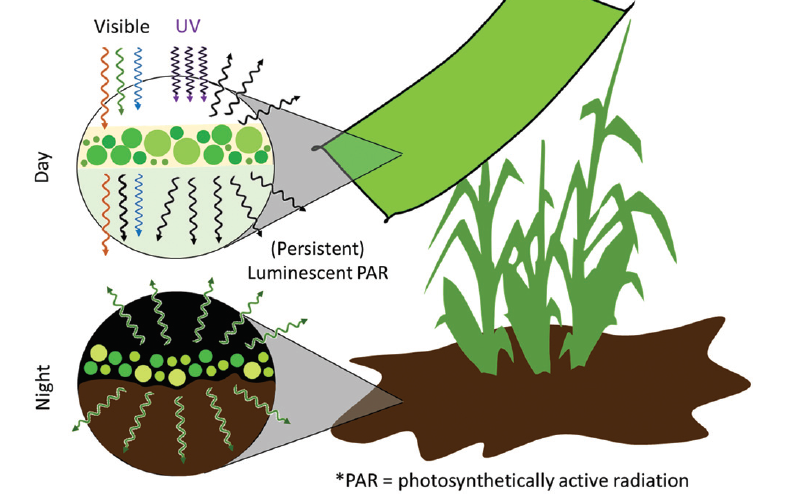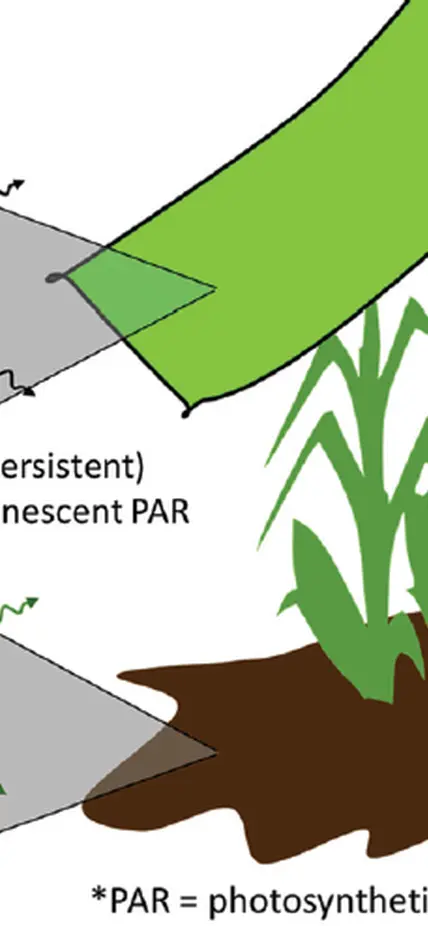Palo Alto, CA— What if we could increase a plant’s productivity by modifying the light to which it is exposed? This could increase the yield of important food and biofuel crops and also combat climate change by sequestering atmospheric carbon.
In a recent perspective piece in Energy and Environmental Science, Carnegie’s Arthur Grossman and Petra Redekop joined colleagues from Stanford University—Larissa Kunz, Matteo Cargnello, and Arun Majumdar—and University of Illinois Urbana Champaign’s Donald Ort to argue that specially engineered lighting modifications through the use of photoluminescent material could drive a next big leap in the green revolution that started in the 1960s.
“For thousands of years, humans selectively bred plants for food, textiles, and construction,” Grossman explained. “In recent decades, advanced genetic manipulation has elevated plant productivity and the quality and quantity of its biomass. But there are still engineering strategies for enhancing productivity that have not been explored.”
Plants can convert the Sun’s energy into chemical energy—sugars, proteins, and fats—for food. This process, called photosynthesis, is fundamental to life as we know it on Earth.
Photosynthesis is the reason our planet’s atmosphere is oxygen rich, allowing humans and other animals to breathe. It is also the baseline source of our entire food supply—directly through consumption of fruits, vegetables, grains, and other plant products, and, for meat eaters, indirectly through consumption of animals that themselves ate plants.
What’s more, photosynthetic reactions require carbon dioxide, which means that plants are taking up and sequestering some of the carbon emissions derived from human activity, which is polluting the atmosphere and causing global climate change.
However, most plants use sunlight very inefficiently; less than 10 percent of the incident light that hits a plant’s leaves is actually used for photosynthesis. This makes light exposure a good target for engineering solutions to global problems, including hunger and climate change.
“Organisms on land take up about 120 gigatons of carbon a year and the oceans take up an additional 90 gigatons annually,” Redekop explained. “If land-based plants could improve the efficiency of their carbon dioxide uptake and utilization by just 3.3 percent, it would have a major impact on food production and also help fight climate change.”
In their essay, Grossman and his co-authors explored the idea of increasing the light available for photosynthetic activity by embedding a luminescent compound into a material matrix that is suspended over plants or strewn across the ground where they are growing. This could temporally redistribute the available sunlight and counteract temporary shade caused by wind or clouds, allow the light to penetrate deeper into an arboreal canopy, lessen the damage caused to plants by excess light, and perhaps, as the system is further developed, extend the hours to which a plant is exposed to light. The material science approach used, called “phytophotonic” engineering, represents an exciting path in the development of agricultural practices.
The authors think this is a good time to explore this engineering approach. This is due not only to technological developments, but also to recent research that upended scientists’ understanding of the role of green light in driving photosynthesis.
It’s long been known that red or blue light is preferentially absorbed when looking at photosynthesis on the level of a single leaf. But it turns out that when studying a forest or whole plants that have layers of leaves, green light plays an important role in photosynthetic activity because it penetrates more deeply and activates photosynthesis in leaves closer to the ground. This means that there is an opportunity to engineer and deploy luminescent materials that emit green light- in a greenhouse or field.
“If we want to meet the challenges of the coming decades, we are going to need to make leaps forward in terms of our ability to improve plant productivity,” Grossman concluded. “This means that multiple avenues must be simultaneously pursued, including how to increase light availability for important crops.”

